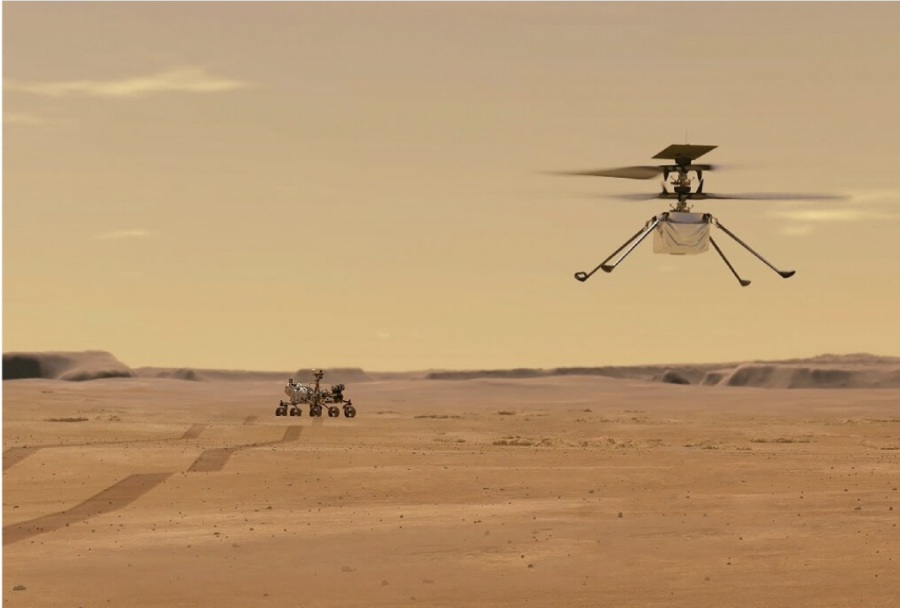Ingenuity – The First Aircraft in History to Make a Powered Flight on Another Planet
A Mars Rover and a Mars Flyer (Artist’s Concept)
What is Ingenuity?
NASA’s Ingenuity Mars Helicopter is the first aircraft humanity has sent to another planet to attempt powered, controlled flight. If its experimental flight test program succeeds, the data returned could benefit future explorations of the Red Planet – including those by astronauts – by adding the aerial dimension, which has not been available until today. Other examples of technical demonstrations that might be familiar are the Mars Pathfinder Rover, Sojourner, and the Mars Cube One, MarCO, that flew past Mars in 2018.
Ingenuity is a ride-along to Perseverance’s mission, and its objective is to exemplify rotorcraft flight in the thin atmosphere of Mars. Temperatures on Mars are drastically different from Earth, with nights as cold as -130 degrees Fahrenheit or -95 degrees Celsius. Because Mars’s atmosphere is denser than the Earth’s, Ingenuity’s rotor blades are more extensive and spin faster for a helicopter of Ingenuity’s mass on Earth.
“One of the most fascinating things about Ingenuity is overcoming the difficulty of creating lift in Mars’ thin atmosphere. To lift the tiny rotorcraft, the counter-rotating blades have to be much larger and spin much faster than a comparable drone on Earth,”Julie Townsend, a JPL engineer who worked on Perseverance and Mayfield Robotics mentor commented
The distance between Ingenuity and the engineers at JPL means that the helicopter’s flight controllers will not be able to control it with a joystick. This means that Ingenuity will have to make its own decisions based on the parameters set by its engineers. During flight, the helicopter will be able to analyze sensory data and images of the terrain to stay set on the flight that was programmed to follow.
The Flights of Ingenuity
The first flight, second flight, and third flights, tested Ingenuities capabilities in the red planet’s rarefied atmosphere. Its pioneering aspirations are similar to those of the Wright brothers’ Flyer, which achieved the first powered, controlled flight on Earth. . Ingenuity was scheduled for the fourth flight on April 29th; however, a glitch prevented the rotorcraft from switching into flight mode. The plan for the fourth flight was to fly the helicopter to an altitude of 5 meters, collect images of the landscape and head back to its original spot. The next day, April 30th, Ingenuity completed its test flight with NASA tweeting:
https://twitter.com/NASAJPL/status/1388200058491789315
Ingenuity has also completed its fifth flight, where its primary focus was on Perseverance and observing how it could assist the rover in studying Mars and discovering ancient microbial life.
During the sixth flight, the goal was to expand the flight envelope and demonstrate its “aerial-imaging capabilities.” Towards the end of the flight, Ingenuity began adjusticing its velocity, causing it to tilt back and forth in an oscillating motion. Around 54 seconds into the flight, a glitch occurred in the pipeline delivering images, causing a single image to be lost. It also resulted in later navigation images with inaccurate timespants.
The Future of Robotics on Mars
Explaining the process and building of Ingenuity, JPL published: “In careful steps over six years, engineers on the Ingenuity team were able to demonstrate that it was possible to build something ultra-lightweight that could generate enough lift in Mars’ thin atmosphere to take off from the ground, and that could operate and survive autonomously in the challenging Martian environment.” If successful, other advanced flying robots could be part of the future mission to Mars. These future helicopters can provide more information on Mars, including new viewpoints, high definition images, access to certain terrains that rovers like Perseverance may not be able to reach, and so much more.
“Something I love about ingenuity is how versatile it is. I believe that everyone possesses it, whether they express it through art or engineering,” said Ashley Dalisay 22 about what impact she believes Ingenuity’s accomplishment made on young engineers.
“Personally, I am extremely grateful to have had the opportunity to express and develop my ingenuity through robotics,” said Dalisay. “It’s inspiring to see young people use their creativity and discover different approaches to certain topics.”

Heidi is a senior at Mayfield Senior School and is thrilled to be a part of Mayfield’s Crier, serving as the News Co-Editor in Chief and Assignment Manager....


